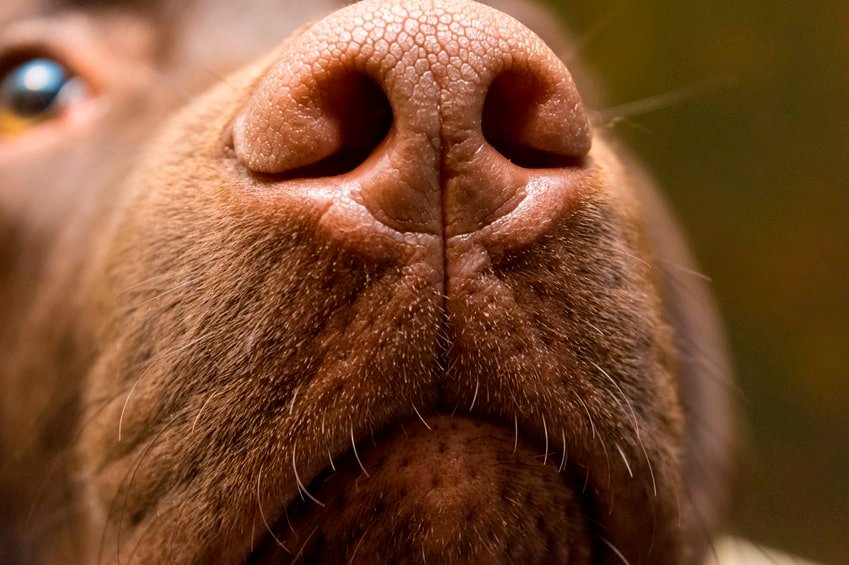Table of Contents
Have you ever wondered why your dog has a wet nose? Or why they eat grass? And what about those moments when they suddenly start zooming around the room? Modern technology is here to help answer these burning questions about your furry friend’s behavior. It turns out that a dog’s wet nose is not only to regulate their body temperature but to also interpret odors. And when they eat grass, it could be due to dietary fiber, ancestral instincts, or simply boredom or anxiety. So, the next time your dog starts zooming around, know that it’s just a burst of energy common in younger dogs. And when they’re excited or anxious, they might also shake a little. Stay tuned to discover even more fascinating facts about your canine companion!

Understanding Unusual Dog Behavior
As a dog owner, you may have encountered some unusual behavior from your furry friend. Whether it’s a wet nose, eating grass, or shaking, it’s important to understand the reasons behind these behaviors. By gaining knowledge about the causes and benefits of unusual behavior, as well as the role of modern technology, you can develop a deeper understanding of your canine companion.
Causes of Unusual Behavior
Unusual behavior in dogs can be attributed to various factors, including physical, emotional, and environmental influences.
Physical Factors
Physical factors, such as underlying health conditions or discomfort, can contribute to unusual behavior in dogs. It’s important to be aware of any signs of illness or pain that your dog may be experiencing, as these can manifest in their behavior.
Emotional Factors
Just like humans, dogs can experience a range of emotions, including anxiety, fear, stress, and excitement. These emotions can influence their behavior and manifest in ways that may seem unusual. Understanding your dog’s emotional state can help you address any underlying issues.
Environmental Factors
The environment in which your dog lives can also affect their behavior. Changes in routine, new surroundings, or exposure to unfamiliar stimuli can lead to unusual behavior. By providing a stable and stimulating environment, you can help minimize any potential behavioral issues.
Benefits of Understanding Behavior
Taking the time to understand your dog’s unusual behavior can have a positive impact on your relationship with them and their overall well-being.
Improved Relationship
By gaining insight into why your dog behaves the way they do, you can develop a stronger bond with them. Understanding their triggers, needs, and desires will allow you to better meet their emotional and physical requirements, leading to a happier and healthier partnership.
Early Detection of Health Issues
Unusual behavior can sometimes be a sign of an underlying health concern. By observing changes in behavior and seeking veterinary advice when needed, you can potentially catch health issues early on, leading to more successful treatment outcomes.
Effective Training and Behavior Modification
Understanding the causes behind your dog’s behavior can make training and behavior modification more effective. By addressing the root cause of the behavior, rather than simply correcting the behavior itself, you can better guide and support your dog in making positive changes.
Modern Technology’s Role
In this digital age, modern technology plays a significant role in helping dog owners understand and address unusual behavior.
Online Resources and Information
The internet provides a wealth of information on dog behavior. From articles and blogs written by experts to reputable websites dedicated to dog care, you can find answers to your questions and gain insights into your dog’s behavior.
Video Tutorials and Demonstrations
Online video platforms offer a visual and practical way to learn about dog behavior. Watching tutorials and demonstrations can help you better understand the body language and signals that dogs use to communicate and express themselves.
Virtual Communities and Forums
Joining virtual communities and forums allows you to connect with other dog owners and professionals. By sharing experiences, seeking advice, and asking questions, you can gain support and learn from others who have faced similar challenges with their dogs’ behavior.
Mobile Applications for Tracking Behavior
There are mobile applications available that can help you track and monitor your dog’s behavior. These apps can assist with training, behavior modification, and tracking any changes or improvements over time. By utilizing technology, you can have a more comprehensive understanding of your dog’s behavior patterns.

Common Dog Behavior Questions
Now that we’ve explored the causes and benefits of understanding unusual dog behavior, let’s dive into some common questions that dog owners often have.
Wet Noses: What Does It Mean?
One of the most common behaviors you may have noticed in your dog is a wet nose. Contrary to popular belief, a wet nose is not an indicator of health or illness. Rather, it is a result of a natural process involving saliva and mucus.
The saliva and mucus mixture on a dog’s nose serve several purposes. Firstly, it aids in thermoregulation, helping to regulate their body temperature. Secondly, it plays a role in smell interpretation, as dogs rely on their highly sensitive noses to gather information about their environment. The moisture on their nose helps to enhance their olfactory abilities.
Why Do Dogs Eat Grass?
Observing your dog eating grass may seem peculiar, but it is a behavior that can have multiple explanations. One common reason is dietary fiber and digestion. Dogs may instinctively eat grass to help regulate their digestion and relieve any stomach discomfort.
Another potential reason is rooted in ancestral instincts. Dogs are descendants of carnivorous predators, and in the wild, their ancestors would consume the stomach contents of their prey, which often included vegetation. Eating grass may be a way for dogs to fulfill this natural instinct.
Lastly, dogs may eat grass out of boredom or anxiety relief. Similar to humans reaching for comfort food, dogs may turn to grass as a form of self-soothing. Providing mental and physical stimulation through toys, exercise, and quality time can help minimize this behavior.
Do Dogs Really Hate Cats?
The idea that dogs hate cats is a societal myth. While some individual dogs may not get along with cats due to personal experiences, it is not an ingrained hatred. Dogs and cats can form positive relationships with proper introduction and socialization.
However, it is important to note that dogs have innate hunting instincts, and smaller creatures, including cats, may trigger those instincts. This behavior is not driven by hatred but rather by the natural prey drive within dogs. With proper training, guidance, and supervision, dogs and cats can coexist peacefully.
What Are ‘Zoomies’?
If you’ve ever witnessed your dog suddenly burst into a frenzy of running and playing, you’ve experienced the phenomenon known as ‘zoomies’. Zoomies are spontaneous bursts of energy that dogs, particularly younger ones, display. This behavior is perfectly normal and natural for dogs.
Zoomies often occur when dogs are feeling playful or excited. They may run around in circles, jump, and exhibit high levels of energy. These bursts of energy are a healthy and fun way for dogs to release pent-up energy. Providing regular exercise and playtime can help prevent excessive zoomies and keeps your dog physically and mentally stimulated.
Why Do Dogs Love Squeaky Toys?
If your dog gets excited at the sound of a squeaky toy, there’s a scientific reason behind it. Dogs are natural hunters, and the high-pitched squeak of a toy mimics the noises made by small rodents or prey animals. This sound triggers a reward response in their brain, releasing dopamine and providing a sense of satisfaction.
Squeaky toys can also provide mental stimulation and entertainment for dogs. The challenge of squeaking the toy and discovering where the sound is coming from engages their natural problem-solving skills and keeps them entertained.
Why Do Dogs Sleep So Much?
You may have noticed that dogs seem to sleep a lot, sometimes even more than humans. There are several reasons behind their sleeping habits.
One factor is disrupted REM (rapid eye movement) sleep cycles. Dogs experience shorter REM cycles compared to humans, which means they need to sleep for longer periods to get adequate rest.
Another reason for excessive sleeping is boredom in the home environment. Dogs that do not receive enough mental and physical stimulation may resort to sleeping as a means of passing time. Ensuring that your dog has plenty of exercise, playtime, and mental enrichment can help maintain a healthy balance of sleep and activity.
The Tale of Tails: Decoding Dog Communication
A dog’s tail is an important tool for communication. The position, wagging speed, and overall movement of their tail can convey various emotions and messages.
Wagging tail: A wagging tail can indicate excitement, happiness, friendliness, or a general positive emotion. The speed and intensity of the wag can provide additional context.
Tucked tail: A tucked tail is a sign of fear, anxiety, or submission. It indicates that the dog is feeling threatened or uncomfortable in their current situation.
High, stiff tail: A high and stiff tail typically signals alertness, confidence, or potential aggression. It can serve as a warning sign to other dogs or individuals to maintain distance.
Understanding how to interpret a dog’s tail language can help you gauge their emotional state and respond accordingly.
Why Do Dogs Shake?
There are several reasons why dogs may shake. Shaking can be a normal behavior or a sign of underlying emotions or physical discomfort.
Shaking due to excitement: Dogs may shake when they are excited, such as during playtime or when anticipating something enjoyable like a walk or meal.
Shaking due to pain, fear, or anxiety: Dogs may shake if they are experiencing pain, fear, or anxiety. It’s important to assess the situation and try to identify any potential triggers or sources of discomfort.
Shaking when cold: Dogs may shake when they are cold as a way to generate body heat and warm up. Providing them with a warm and comfortable environment can help alleviate this behavior.
If your dog’s shaking persists or is accompanied by other concerning symptoms, it’s advisable to consult with a veterinarian for a comprehensive evaluation.
Why Do Dogs Eat Poop?
While it may seem repulsive to us, dogs eating poop, a behavior known as coprophagia, is not uncommon. There are several reasons why dogs engage in this behavior.
Biological instincts: In the wild, dogs and their ancestors would clean up after themselves and their pack by consuming waste to prevent attracting predators. This instinct may still be present in domesticated dogs.
Nutrient deficiencies: Some dogs may eat poop if they are lacking certain nutrients in their diet. It’s important to ensure that your dog is receiving a balanced and nutritious diet.
Hunger: Dogs may resort to eating poop if they are not getting enough food or if they are on a restricted diet. Ensuring that your dog is adequately fed and has access to appropriate portions can help address this behavior.
Enzyme deficiencies: In some cases, dogs may have enzyme deficiencies that affect their ability to fully digest their food. This can result in undigested nutrients being present in their waste, which may be appealing to them.
If your dog’s coprophagia persists or becomes a concern, consulting with your veterinarian is recommended to rule out any underlying health issues and address the behavior.
The Joy of Belly Rubs
For many dogs, belly rubs are a delightful experience that they can’t get enough of. There are a few reasons why dogs enjoy this form of physical affection.
Inability to reach belly: Dogs have limited mobility and flexibility when it comes to reaching their own bellies. A belly rub from their owner provides the physical contact and relief that they can’t achieve themselves.
Relief for itchy skin: Belly rubs can provide relief for dogs with itchy skin caused by allergies, dryness, or other skin conditions. The gentle pressure and rubbing motion can soothe irritated areas and provide temporary relief.
Bonding experience with owner: Dogs are social animals and value the bond they have with their owners. Belly rubs create a positive association and allow for a special moment of connection between the dog and their owner.
As with any physical contact, it’s important to be mindful of your dog’s boundaries and comfort levels. Observe their body language and cues to ensure that they are enjoying the belly rub and not exhibiting any signs of discomfort or stress.
In conclusion, understanding unusual dog behavior is essential for building a strong relationship with your canine companion and ensuring their well-being. By examining the causes of unusual behavior, recognizing the benefits of understanding it, and harnessing the power of modern technology, you can navigate through any quirks or challenges that arise with your furry friend. So, embrace your role as a knowledgeable and empathetic dog owner, and enjoy the journey of understanding your dog’s unique behaviors.




